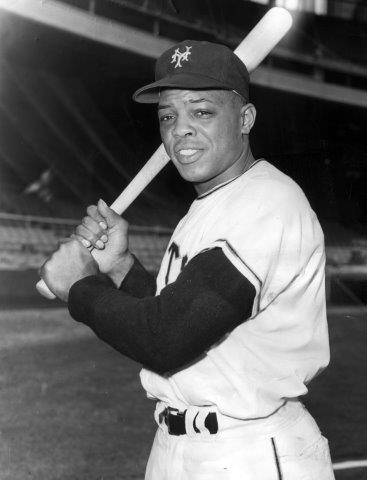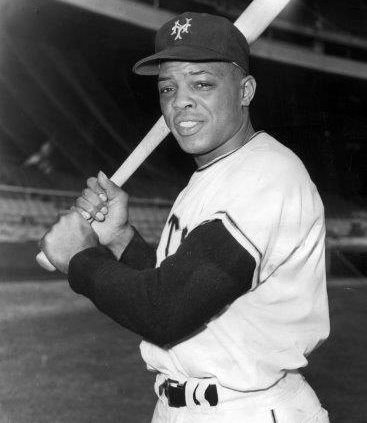June 7, 1956: Willie Mays homers twice in Giants’ exhibition win at Metropolitan Stadium
 Six weeks after Opening Day at their new $4.5 million ballpark in Bloomington, Minnesota, the Minneapolis Millers hosted the New York Giants for an exhibition game. Local newspaperman Jim Klobuchar described the still unnamed facility as “an ornate blend of steel, affectionate dreams and civic pride.”2 His colleague Bob Beebe hailed it as “a construction miracle” for going from concept to baseball-ready in just 19 months. But crews were still scrambling to complete the project before the June exhibition after an explosion and fire in the third-base grandstand on February 26 necessitated significant reconstruction of the affected area, a six-week (and counting) inconvenience.3
Six weeks after Opening Day at their new $4.5 million ballpark in Bloomington, Minnesota, the Minneapolis Millers hosted the New York Giants for an exhibition game. Local newspaperman Jim Klobuchar described the still unnamed facility as “an ornate blend of steel, affectionate dreams and civic pride.”2 His colleague Bob Beebe hailed it as “a construction miracle” for going from concept to baseball-ready in just 19 months. But crews were still scrambling to complete the project before the June exhibition after an explosion and fire in the third-base grandstand on February 26 necessitated significant reconstruction of the affected area, a six-week (and counting) inconvenience.3
Only 21,690 of the planned 30,000 seats were installed in time for the game. Undaunted, Millers business manager George Brophy expressed confidence that fans would buy as many as 2,000 standing-room tickets to congregate behind the chain-link outfield fences for the third annual Giants-Millers showdown.4 Alas, just 142 fans invested in the $1.10 SRO ducats, including a group who took in the action while seated on wooden crates behind the right-field boundary.5 In all, 21,832 fans paid to see the game. Workers spent the days and hours before the game touching up paint and preparing for the largest crowd ever to assemble for a baseball game in the Upper Midwest.6 The final number for the $100,000 scoreboard was put in place just an hour before the first pitch.7
The towering, triple-decked stadium didn’t rise from 164 acres of farmland8 to accommodate the Triple-A Millers. They were merely short-term tenants whose residency (and existence) might expire at any time. The easily expandable ballpark was erected to sell Major League Baseball on the viability of Minneapolis as a major-league city, and the exhibition was a chance to show how good it looked with big-league talent on the field.
Giants owner Horace Stoneham vented publicly about his displeasure with his club’s New York home, the Polo Grounds, and, like Brooklyn Dodgers owner Walter O’Malley, he lobbied for a new ballpark while threatening relocation. A move to Minneapolis made sense. The Giants owned the Millers, so supplanting them would be a simple in-house transaction. On a boozy night in a Minneapolis hotel suite in January of 1954, he allegedly told Brophy and other Millers employees that he had plans to move the Giants to Minneapolis as part of a scheme that would also relocate the Cincinnati Redlegs to New York.9 A year and a half later, Minnesota’s major-league-ready ballpark beckoned.
A move to the Minneapolis metropolitan area was an enticing proposition for many reasons in 1956. With a population approaching 1.5 million, the Twin Cities metropolitan area was growing quickly and had established its baseball bona fides, supporting two top-notch American Association clubs for more than 50 years. The Millers won the American Association pennant and the Junior World Series in 1955. The University of Minnesota baseball team was on a roll in 1956, too.
Just days before the Giants-Millers game, the Gophers defeated Ohio University to advance to the College World Series, a tournament they would win a week later. Minnesota’s politicians and titans of business lobbied aggressively for the Twin Cities to join the roster of major-league cities. Newspaper coverage of the exhibition made it clear that the Giants were the primary target of the campaign to replace the Millers.
Stoneham had flown into Bloomington for Opening Day in April, the first game ever played at the new ballpark, and he would return for its dedication game on June 27, but he skipped the exhibition. Instead, the Giants sent a clutch of executives to Bloomington to attend the game and attend to some urgent business beforehand. Vice president Chub Feeney, farm director Carl Hubbell, and chief scout Tom Sheehan met up with rookie Giants manager Bill Rigney the day before the exhibition. The group huddled with Millers general manager Rosy Ryan for much of the afternoon to discuss potential trades.
The Giants needed help. They’d slumped into Minnesota as losers of nine of their previous 12 games, in sixth place, nine games under .500, and 8½ games behind the first-place Cardinals, Pirates, and Redlegs.10 The exhibition provided the New York club a brief but much-needed respite from major-league competition.
Eager though the fans may have been to see the Giants, “it was a late crowd that came from all over the state” for the 8:00 P.M. start, according to Minneapolis Star and Morning Tribune executive sports editor Charles Johnson. “There were slowdowns in traffic and some late arrivals in the stands, but the combined efforts of police, sheriffs, civilian defense, Shriners and private individuals took it in stride to move more than 9,000 cars into the huge parking area with much less delay than anyone expected.”11 Once settled in their seats, they witnessed a good game.
The Millers initiated the scoring with a long Gail Harris home run to right off Ramon Monzant in the second inning. In the fourth, Al Dark doubled for the Giants and Willie Mays followed with “a towering blast which cleared the left field fence and landed at the base of the outer fence up a high embankment,” according to Bob Beebe. It was the farthest Mays had hit a ball in 1956 and his first home run since May 15.12
Mays famously spent a little more than a month with the Millers five years earlier, abusing American Association pitching to the tune of a .477/.524/.799 slash line in 35 games to force his ascension to the Giants at age 20. On this night, of the 16 Giants to appear in the game, the “Say Hey Kid” was one of 13 who had previously played for the Millers.13 Additionally, rookie Giants manager Rigney was the Millers player-manager in 1954-55 and Sheehan pitched for the team in 1931 and managed them from 1939 to 1943 and in 1946-47.
Most in the crowd had come to watch Mays, and he delivered again in the sixth, crushing his second circuit clout of the game to punctuate the two-run inning. The Millers responded in the seventh, plating three runs to tie via Willie Kirkland and Bob Lennon singles, a fielder’s choice grounder by Willie Harris, and Jake Jenkins’s homer. The Giants answered with a run in both the eighth and ninth innings, and knuckleballer Hoyt Wilhelm stymied the Millers to lock down the 6-4 win for the big leaguers.
Although the Minneapolis club lost on the field, its new home won over all the right people and secured a victory for the future of baseball in the Twin Cities. Joe King of the New York World Telegram asserted from his seat in the press box, “If Horace Stoneham had this Bloomington stadium in New York, just as it is, mind you, he’d draw over 1,250,000 people” per season. “Nobody likes to go to the Polo Grounds,” he continued. “It’s a freak and it’s rather old and run down.”14
Giants players were likewise impressed, stopping short of besmirching their New York home while drawing a clear distinction. “Great lights,” said outfielder Dusty Rhodes. His compatriot George Wilson completed the sentiment, “Yeah, easy to pick up the ball in the outfield.”15 In the next morning’s Minneapolis Tribune, sportswriter Sid Hartman quoted King, who echoed what Twin Cities locals insisted: “The folks here are in the big league business now because they have the stadium. If the Giants aren’t forced to come here, another team may gratefully take advantage of the facilities.”16
Notes
1 The new stadium did not become Metropolitan Stadium until July 1956.
2 Jim Klobuchar, “Bloomington Stadium Nears Readiness for Miller Opener,” St. Cloud (Minnesota) Times, April 9, 1956: 5.
3 Bob Beebe, “Triple-Decked Stadium Is a Construction ‘Miracle,’” Minneapolis Sunday Tribune, April 22, 1956: 16.
4 Donald Brostrom, “Record 23,000 to See Millers Play Giants,” Minneapolis Star, June 7, 1956: 1.
5 Bonham Cross, photographer, “Giants Fill Stadium – and Then Some,” Minneapolis Morning Tribune, June 8, 1956: 18.
6 Charles Johnson, “21,832 See Stadium Pass Another Test,” Minneapolis Morning Tribune, June 8, 1956: 1D.
7 Bob Beebe, “White: Never Can Let Down in Major League,” Minneapolis Star, June 8, 1956: 4D.
8 Pat Borzi, “The Giants Almost Headed Not Quite So Far West,” New York Times, June 17, 2005.
9 Jay Weiner, Stadium Games: Fifty Years of Big League Greed and Bush League Boondoggles (Minneapolis: University of Minnesota Press, 2000), 11.
10 Chris Kieran, “Wanted: Some Hits! Giants in the Market,” New York Daily News, June 7, 1956: C24.
11 Charles Johnson, “21,832 See Stadium Pass Another Test,” Minneapolis Morning Tribune, June 8, 1956: 43.
12 Bob Beebe, “Millers, Giants Both Profit from Game,” Minneapolis Star, June 8, 1956: 43.
13 Bob Beebe, “White: Never Can Let Down in Major League.”
14 Halsey Hall, “Stadium, as Is, Would Attract 1,296,000 in New York,” Minneapolis Star, June 8, 1956: 1D.
15 Hall.
16 Sid Hartman, “Stadium Praised; Move Speculated,” Minneapolis Morning Tribune, June 8, 1956: 24, 26.
Additional Stats
New York Giants 6
Minneapolis Millers 4
Metropolitan Stadium
Bloomington, MN
Corrections? Additions?
If you can help us improve this game story, contact us.


